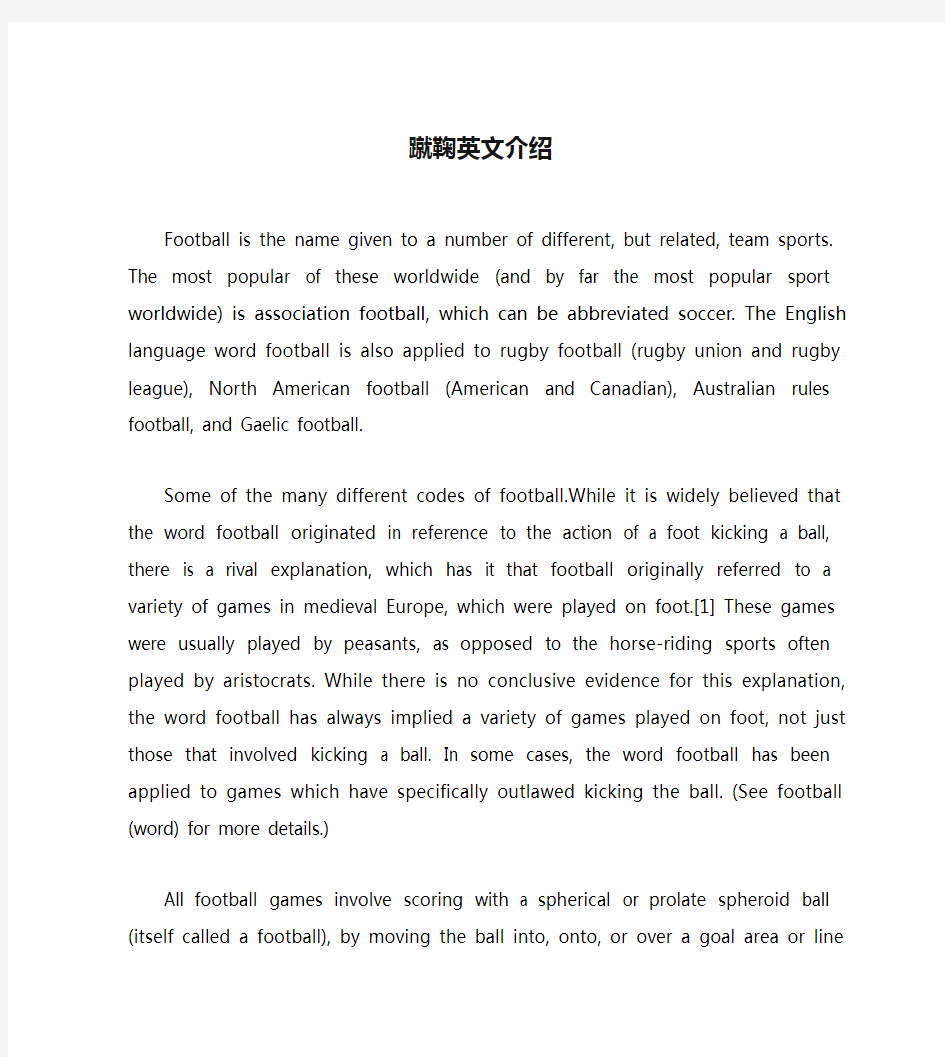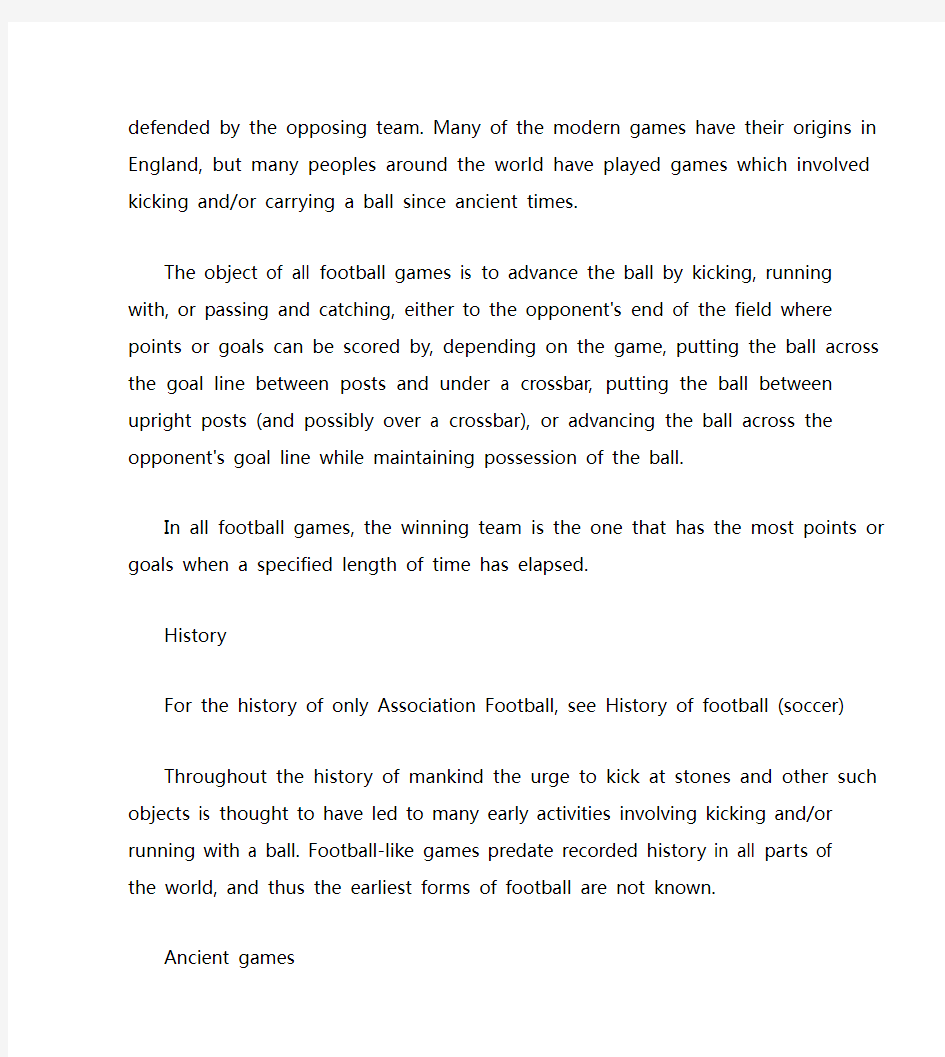蹴鞠英文介绍


蹴鞠英文介绍
Football is the name given to a number of different, but related, team sports. The most popular of these worldwide (and by far the most popular sport worldwide) is association football, which can be abbreviated soccer. The English language word football is also applied to rugby football (rugby union and rugby league), North American
football (American and Canadian), Australian rules football, and Gaelic football.
Some of the many different codes of football.While it is widely believed that the word football originated in reference to the action of a foot kicking a ball, there is a rival explanation, which has it that football originally referred to a variety of games in medieval Europe, which were played on foot.[1] These games were usually played by peasants, as opposed to the horse-riding sports often played by aristocrats. While there is no conclusive evidence for this explanation, the word football has always implied a variety of games played on foot, not just those that involved kicking a ball. In some cases, the word football has been applied to games which have specifically outlawed kicking the ball. (See football (word) for more details.) All football games involve scoring with a spherical or prolate spheroid ball (itself called a football), by moving the ball into, onto, or over a goal area or line defended by the opposing team. Many of the modern games have their origins in England, but many peoples around the
world have played games which involved kicking and/or carrying a ball since ancient times.
The object of all football games is to advance the ball by kicking, running with, or passing and catching, either to the opponent's end of the field where points or goals can be scored by, depending on the game, putting the ball across the goal line between posts and under a crossbar, putting the ball between upright posts (and possibly over a crossbar),
or advancing the ball across the opponent's goal line while maintaining possession of the ball.
In all football games, the winning team is the one that has the most points or goals when a specified length of time has elapsed.
History
For the history of only Association Football, see History of
football (soccer)
Throughout the history of mankind the urge to kick at stones and
other such objects is thought to have led to many early activities involving kicking and/or running with a ball. Football-like games
predate recorded history in all parts of the world, and thus the
earliest forms of football are not known.
Ancient games
Documented evidence of what is possibly the oldest organized
activity resembling football can be found in a Chinese military manual written during the Han Dynasty in about 2nd century BC.
It describes a practice known as cuju (Traditional Chinese: 蹴鞠; Simplified
Chinese: 蹴踘; Pinyin: cù jū) which involved kicking a leather ball through a hole in a piece of silk cloth strung between two 30 foot poles. Another Asian ball-kicking game, which may have been influenced by cuju, is kemari. This is known to have been played within the Japanese
imperial court in Kyoto from about 600 AD. In kemari several individuals stand in a circle and kick a ball to each other, trying not to let the ball drop to the ground (much like keepie uppie). The game survived through many years but appears to have died out sometime before the mid 19th century. In 1903 in a bid to restore ancient traditions the game was revived and it can now be seen played for the benefit of tourists at a number of festivals.
Mesoamerican ballgames played with rubber balls are also well-documented as existing since before this time, and are thought to have resembled football in their earlier versions; but since later versions have more similarities to basketball or volleyball, and since their influence on modern football games is minimal, most do not class them as football.
The Greeks and Romans are known to have played many ball games some
of which involved the use of the feet. The Roman writer Cicero describes the case of a man who was killed whilst having a shave when a ball was kicked into a barbers shop. The Roman game of Harpastum is believed to have been adapted from a team game known as "επισκ,ρο?"
(episkyros) or pheninda that is mentioned by Greek playwright, Antiphanes (388-311BC) and later referred to by Clement of Alexandria. The game appears to have vaguely resembled rugby.
There are a number of less well-documented references to prehistoric, ancient or traditional ball games, played by indigenous peoples all around the world. For example, William Strachey of the Jamestown settlement is the first to record a game played by the Native Americans called Pahsaheman, in 1610.
In Victoria, Australia, Indigenous Australians played a game called Marn Grook. An 1878 book by Robert Brough-Smyth, The Aborigines of Victoria, quotes a man called Richard Thomas as saying, in about 1841, that he had witnessed Aboriginal people playing the game: "Mr Thomas describes how the foremost player will drop kick a ball made from the skin of a possum and how other players leap into the air in order to catch it." It is widely believed that Marn Grook had an influence on the development of Australian rules football (see below). In northern Canada and/or Alaska, the Inuit (Eskimos) played a game on ice called Aqsaqtuk. Each match began with two teams facing each other in parallel lines, before attempting to kick the ball through each other team's line and then at a goal.
These games and others may well go far back into antiquity and have influenced football over the centuries. However, the route towards the development of modern football games appears to lie in Western Europe
and particularly England
梵高英语简介
Something about Vincent Vincent Willem van Gogh was a post-Impressionist painter of Dutch origin whose work, notable for its rough beauty, emotional honesty and bold color, had a far-reaching influence on 20th-century art. Van Gogh began to draw as a child, and he continued to draw throughout the years that led up to his decision to become an artist. He did not begin painting unti l his late twenties, completing many of his best-known works during the last two years of his life. In just over a decade, he produced more than 2,100 artworks, consisting of 860 oil paintings and more than1,300 watercolors,drawings, sketches and prints. His work included self portraits, landscapes, still lifes, portraits and paintings of cypresses, wheat fields and sunflowers. Van Gogh spent his early adulthood working for a firm of art dealers,. One of his early aspirations was to become a pastor and from 1879 he worked as a missionary in a mining region in Belgium where he began to sketch people from the local community. In 1885, he painted his first major work The Potato Eaters.. Later, he moved to the south of France and was influenced by the strong sunlight he found there. His work grew brighter in color, and he developed the unique and highly recognizable style that became fully realized during his stay in Arles in 1888. After years of painful anxiety and frequent bouts of mental illness,[1][2] he died aged 37 from a gunshot wound, generally accepted to be self-inflicted (although no gun was ever found).[3][note 2] His work was then known to only a handful of people and appreciated by fewer still. Quarrel with firend
闻香识女人
组织教学 导入新课 闻香识女人,是一部于1992年公映的美国电影。电影叙述了一名预备学校的学生,为一位脾气暴躁的眼盲退休军官担任助手。由艾尔·帕西诺、克里斯·欧唐纳等主演。其中艾尔·帕西诺在多次与奥斯卡金像奖失之交臂后,终于凭借著此片中杰出演出夺得第六十五届奥斯卡最佳男主角。 闻香识女人翻拍自1974年迪诺·莱希的同名电影女人香,该片是片中演员维托力欧·盖斯曼的巅峰之作。而本次的版本除艾尔·帕西诺夺得奥斯卡最佳男主角奖外,影片还获得最佳导演奖,最佳影片奖和最佳改编剧本奖三项奥斯卡提名。另有同名中国和意大利小说。 奥斯卡(美国电影学院奖) 1993年;最佳男主角阿尔·帕西诺;最佳影片 (提名) 马丁·布莱斯;最佳导演 (提名) 马丁·布莱斯;最佳改编剧本 (提名) 博·古德曼;最佳编剧博·古德曼;最佳男配角 (提名) 克里斯·奥唐纳;英国电影学院奖(BAFTA Film Award) 1994;最佳改编剧本 (提名) 博·古德曼;芝加哥影评人协会奖 1993年; 今天我们就来了解《闻香识女人》有关知识,并从主人公身上汲取一些有益的营养。 讲授新课 一、《闻香识女人》剧情简介 年轻的学生查理(克里斯奥唐纳饰)无意间目睹了几个学生准备戏弄校长的过程,校长 让他说出恶作剧的主谋,否则将予以处罚。查理带着烦恼来到退伍军人弗兰克上校(阿尔·帕西诺饰)家中做周末兼职。上校曾经是林登·贝恩斯·约翰逊总统的幕僚,经历过战争和许多挫折,在一次意外事故中双眼被炸瞎。他整天在家里无所事事,失去了生活下去的勇气和信心。他准备用尽最后的精力享受一次美好的生活。他带着查理出游、吃佳肴、开飞车、跳探戈、住豪华酒店……然后想就此结束自己的生命。查理竭力阻止了上校的自杀行为,从此他们之间萌生如父子般的感情。弗兰克也找回了生活下去的勇气和力量。影片最后弗兰克在学校礼堂激昂演说,挽救了查理的前途,讽刺了学校的伪善。二人在互相鼓舞中得到重生。 失明生活使得弗兰克中校对听觉和嗅觉异常敏感,甚至能靠闻对方的香水味道识别其 身高、发色乃至眼睛的颜色。其实这都源于他对生活的深刻理解和感悟。 幕后制作: 一次意外的邂逅、一场“性感”的探戈、一出恣意的飙车和一段酣畅淋漓的演讲为我 们完整地勾勒出生命从“毁灭”到“重生”的全部过程。这部1992年上映的经典影片翻拍自1974年的著名意大利影片《女人香》。原片由著名导演迪诺·里西执导。但是美国版的《闻香识女人》并不是一部简单的翻拍片。相比较原版影片而言,它更加注重影片人物之间的关系,而不像原版影片那样,只是仅仅关注老军官的过去的生活。 编剧博·古德曼把整个故事的视角安在了一个十几岁的高中生的身上,他让这样一个 有点腼腆、不大放得开的孩子去直接面对一个怪异、孤僻的老军官。这样的剧本,对编剧而言就是一项不小的挑战。古德曼认为:“阿尔·帕西诺演的那个军官是一个争强好胜的人,让一个像是软柿子的中学生去和他接触,肯定会有奇妙的化学效果。那个退役的军官,想了
梵高简介
梵高 文森特·威廉·梵高(1853年3月30日-1890年7月29日),荷兰后印象派画家,是表现主义的先驱,并深深影响了二十世纪艺术。梵高早期只以灰暗色系进行创作,直到他在巴黎遇见了印象派与新印象派,融入了他们的鲜艳色彩与画风,创造了他独特的个人画风。他最著名的作品多半是他在生前最后二年创作的,期间梵高深陷于精神疾病中,其最后在他37岁那年将他导向自杀一途。梵高的作品如《星夜》、《向日葵》与《有乌鸦的麦田》等,现已跻身于全球最具名、广为人知与昂贵的艺术作品的行列。 目录 1人物简介 梵高梵高(荷兰语:Vincent Willem van Gogh,1853年3月30日-1890年7月29日),荷兰后印象派画家。他是表现主义的先驱,并深深影响了二十世纪艺术,尤其是野兽派与德国表现主义。梵高的作品,如《星夜》、《向日葵》与《有乌鸦的麦田》等,现已跻身于全球最具名、广为人知与昂贵的艺术作品的行列。 1861年梵高开始受教育,在学习语言包括法语、德语及英语表现不错,但在1868年3月中断学业,并在1869年7月在国际艺术品交易商公司见习。经历了短暂的教职生涯后,他成为传教士,向贫困的采矿工人传教。直到约莫27岁时,梵高才开始了他的画家生涯;然而,在他生前的最后十年间,却创作了超过二千幅画,包括约900幅油画与1100幅素描。梵高早期只以灰暗色系进行创作,直到他在巴黎遇见了印象派与新印象派。梵高融入了他们的鲜艳色彩与画风,创造了他独特的个人画风,其在梵高待在法国亚尔的那段时间,发展已
臻成熟。他最著名的作品多半是在他生前最后二年创作的,期间梵高深陷于精神疾病中,其最后在他37岁那年将他导向自杀一途。 梵高一生中的核心人物是他的弟弟西奥,其从不间断、无私的提供梵高经济资助。他们终身的友谊可于他们在1872年8月前往来的多封书信间查证。 2生平经历 2.1早年生活 梵高文森特·梵高于1853年3月30日出生于荷兰南部北布拉班特省、位置靠近布雷达的村庄津德尔特。他是安娜·柯妮莉雅·卡本特斯与西奥多鲁斯·梵高(Theodorus van Gogh)之子,其父西奥多鲁斯是荷兰归正宗教会的神职人员。文森特以他的祖父为名,其也是恰一年前头一胎死产的哥哥的名字。以此方式重新使用名字的做法并不罕见。文森特在梵高家族中是个常见的名字;他的祖父(1789–1874)于1811年在莱顿大学得到神学学位。祖父文森特有六个儿子,其中三名是艺术品商人,包括另一个在梵高信中称呼其为―零屌叔叔‖的文森特。祖父文森特或许是被轮到以他父亲的叔父——成功的雕刻家文森特·梵高(1729—1802)——命名。艺术与宗教是两项深深吸引著梵高家族的职业。他的弟弟西奥·梵高于1857年5月1日出生。梵高有第三个弟弟柯尔,还有三个姐妹:伊丽莎白、安娜与维尔敏娜。 文森特小时候是个认真、沉默与慎虑小孩。1860年,他到尊得特乡村学校就读,其唯一的老师是天主教徒,并有约二百名学生。自1861年起,他和他的妹妹安娜在家中由家庭女教师指导,一直到1864年10月1日,他到了荷兰泽文伯根的私立珍普洛维利寄宿小学就读,离他家约有20英里(32千米)。 1869年至1876年,他分别在古庇画行(Goupil & Cie)的海牙、伦敦、巴黎分店就职,遭解雇后前往英国的拉拇斯卡托(Ramsgate),在寄宿学校服务。他在1877年于多德雷赫
梵高英语介绍
姓名:Vincent van Gogh 生日:1853年3月30日 职业:画家 去世时间:1890年7月29日 派别:印象派、表现派 性别:男 籍贯:荷兰 供职机构: 经历:为画商工作,当过传教士 代表作:《吃土豆的人们》《夜咖啡》《向日葵》《星夜》《自画像》等 人物简介: 梵高自杀年仅三十七岁,作为一位艺术家,直到死前不久他才以其震憾人心而富于想象力的绘画赢得评论界的赞扬。梵高死后不出几年,一些画家就开始模仿他的画法,为了表现强烈的感情,可以不对现实作如实的反映,这种创造性的态度被称作表现主义,并且证明是现代绘画中一种历久不衰的倾向。 梵高 ——火一样炽热的大画家 (文森特·梵高(1853-1890),荷兰画家。患有精神分裂症。青年时期曾从事宗教活动,后转向绘画,以其对生活的热烈渴 望开辟出一个艺术的新天地。) 梵高出生于一个基督教牧师的家庭。16岁时,他到古比尔美术公司海牙分店当店员,以后又去伦敦分店工作。几年以后,由于 痛苦的失恋和对职业的厌倦,梵高投身宗教,决心做一个福音传道者。 1897年,他25岁时来到比利时南部的博里纳日传教。在那里,几乎人人都做矿工谋生。他们冒着瓦斯中毒和爆炸等危险,挣扎 在死亡线上。梵高怀着极大的同情心来到矿区,只见矿工们穿着破烂的衣服,满脸煤灰,浑身污黑,骨瘦如柴,肩狭背驼,不时有 人发出阵阵的咳嗽声。几天以后,梵高就在一间简陋的席棚里开始了第一次宗教集会。他天天去看望那些身患重病的人,把自己的 大半薪水用在为病人购买仪器和药物上。他甚至把床让出去,自己睡在地板上,村里的病人他全都护理过,每一间草棚他都送去过 牛奶,面包。而自己呢,却由于缺吃少穿,得了热病,瘦得皮包骨头。上司以他超越牧师职责为名,禁止他继续讲道。梵高失去了 “上帝”,他不得不离开这个生活了6个月的苦难深重的地方。 梵高贫困潦倒,到处流浪。这时,他阅读了莎士比亚、狄更斯、雨果的作品,并开始学画素描。1882年,他到海牙学习绘画, 比他小4岁的泰奥是一位画商,每月寄钱供梵高学画。梵高后来艺术上的成功,是与泰奥在物质上、精神上对他的帮助分不开的。 一次,梵高在小酒店遇到了憔悴不堪、被贫困损害了身心的女人西恩。西恩以洗衣为生,有时还得找个男人为她的5个孩子挣
高中英语课文人教版必修六翻译
成功英语高中选修6 Unit1 Art 阅读 1 A short history of western painting 西方绘画艺术简史 艺术是受着人民生活习俗和信仰的影响的。西方的艺术风格经历了多次变革。由于西方的艺术风格多种多样,在短短的一篇课文里不可能进行全面的描述。因此,本文只谈及从公元 6 世纪以来最主要的几种艺术风格。中世纪(公元 5 世纪到 15 世纪) 在中世纪,画家的主要任务是把宗教的主题表现出来。一个传统的艺术家无意于如实地展现自然和人物。那个时期的典型的绘画充满了宗教的(象)特征,体现出了对上帝的爱戴与敬重。但是,很显然到了 13 世纪时观念发生了变化,像乔托这样的画家开始以一种比较现实的风格来画宗教场景。 文艺复兴时期( 15 世纪到 16 世纪) 在文艺复兴时期,新的思想和价值观逐渐取代了中世纪的思想和价值观。人们开始较少关注宗教主题而采取一种更人性化的生活态度。同时画家们回到了罗马、希腊的古典艺术理念上。他们力争如实的画出人物和自然。富人们想拥有自己的艺术品并用来装饰自己的高级宫殿和豪宅,他们出价聘请著名艺术家来为自己画像,画自己的房屋和其他财物,以及他们的活动和成就。在此期间,最重要的发现之一就是如何用透视法来画出事物这一手法是 1428 年由马萨乔第一次使用的。当人们第一次看到他的画时,还以为是透过墙上的小洞来观看真实的场景,并对此深信不疑。如果没有发现透视法,人们就不可能画出如此逼真的画。巧合的是这一时期油画材料也得到了发展,它使得绘画的色彩看上去更丰富、更深沉。没有新的颜料和新的绘画手法,我们就不能看到很多使这一时代著名的杰作。 印象派时期( 19 世纪后期到 20 世纪初期) 19世纪后期,欧洲发生了巨大的变化,从以农业为主的社会变成了以工业为主的社会。许多人从农村迁入到新城市。有着许多新发明,还有许多社会变革。这些变革也自然而然的促成了新的绘画风格。在那些突破传统画法的画家中有生活和工作在法国巴黎的印象派画家。 印象派画家是第一批室外写景的画家。他们急切的想把一天中不同时间投射到物体上的光线和阴影呈现出来。然而自然光的变化很快,印象派的画家必须很快的作画因此,他们的画就不像以前那些画家们的画那样细致了。起初,许多人都不喜欢这样的画法,甚至还怒不可遏。他们说这些画家作画时漫不经心、粗枝大叶,而他们的作品更是荒谬可 笑。 现代艺术( 20 世纪至今) 在印象派作品创建的初期,他们是存在争议的,但是如今以被人们接受,而成为现在我们所说的“现代艺术”的始祖了。这是因为印象派鼓励画家用一种崭新的视角看待他们的环境。如今,现代艺术风格有好几十种,然而如果没有印象派,那么许多不同的风格就不可能存在。一方面,有些现代艺术是抽象的,也就是说,画家并不打算把眼睛看到的东西如实的画出来,而是集中展现物体的某些品质特性,用色彩、线条和形状把他们呈现出来。而另一方面,有些现代派的艺术作品却是那么写实,看上去就像是照片。这些风格如此不同。谁能预言将来会有什么样的绘画艺术风格?
梵高名言英语
梵高名言英语 1、我不知道世间有什么是确定不变的,我只知道,只要一看到星星,我就会开始做梦。 I don't know what's fixed in the world. I just know that once I see the stars, I start dreaming. 2、我越来越相信,创造美好的代价是:努力、失望以及毅力。首先是疼痛,然后才是欢乐。 I am increasingly convinced that the costs of creating good things are hard work, disappointment and perseverance. First pain, then joy. 3、每个人心中都有一团火,路过的人只看到烟。 Everyone has a fire in his heart, and the passers-by sees only smoke. 4、一人绝不可以让自己心灵里的火熄灭掉,而要让它始终不断的燃烧。 One must never extinguish the fire in one's heart, but keep it burning all the time. 5、我梦想着绘画,我画着我的梦想。 I dream of painting, I paint my dream. 6、正常状态好比一条铺好的路:走起来舒服,但长不出花。 Normal condition is like a paved road: it's comfortable to walk, but it doesn't grow flowers. 7、我认为这是伟大人物经历中的一幕悲剧。他们往往再作品被工作所承认之前便死了。 I think this is a tragedy in the great man's experience. They often die before their work is recognized by their work. 8、我的体内存在着某些东西,那是什么呢。 There is something in my body. What is that? 9、天赋总是以阻碍艺术家开始的。我绝不允许那个阻力把我引向歧途。 Genius always begins by hindering artists. I will never allow that resistance to lead me astray. 10、我总是全力以赴地画画,因为我的饿最大愿望是创造美的作品。 I always go all out to paint, because my greatest hunger desire is to create beautiful works. 11、悲伤会永远留存。 Sadness will last forever. 12、每个人的心里都有一团火,路过的人只看到烟。 Everyone has a fire in his heart. Passers-by only see smoke. 13、也许在我们的灵魂中有一团热火,但没有人用它使自己暖和起来。 Maybe there's a fire in our soul, but nobody uses it to warm themselves up. 14、一切我所向着自然创作的,是栗子,从火中取出来的。啊,那些不信仰太阳的人是背弃了神的人。 All that I have created for nature is chestnuts, taken from the fire. Ah, those who do not believe in the sun are those who have betrayed God.
